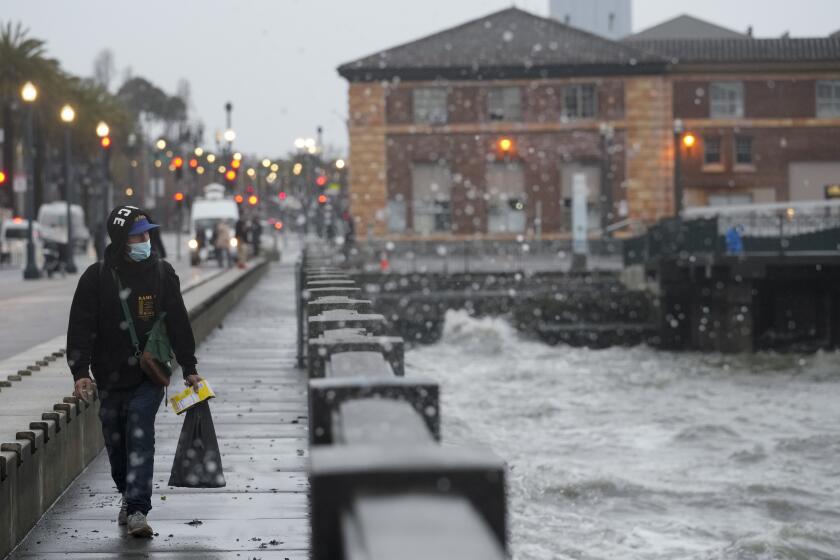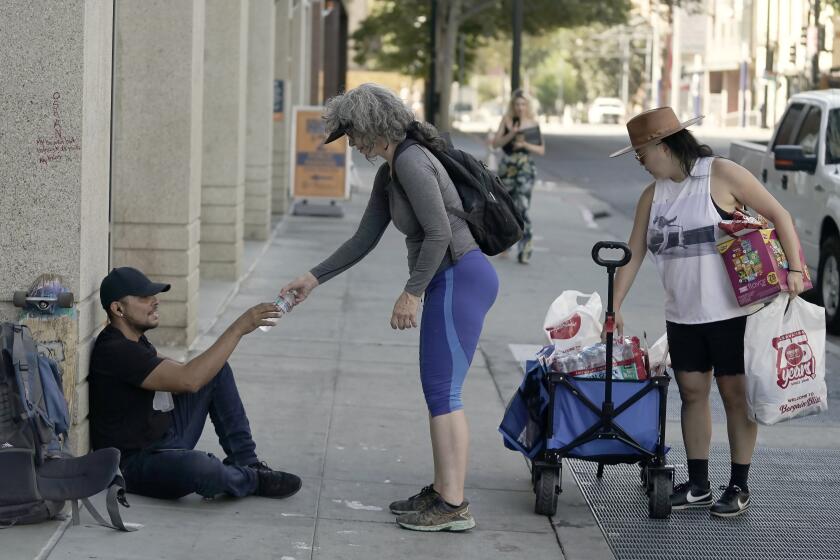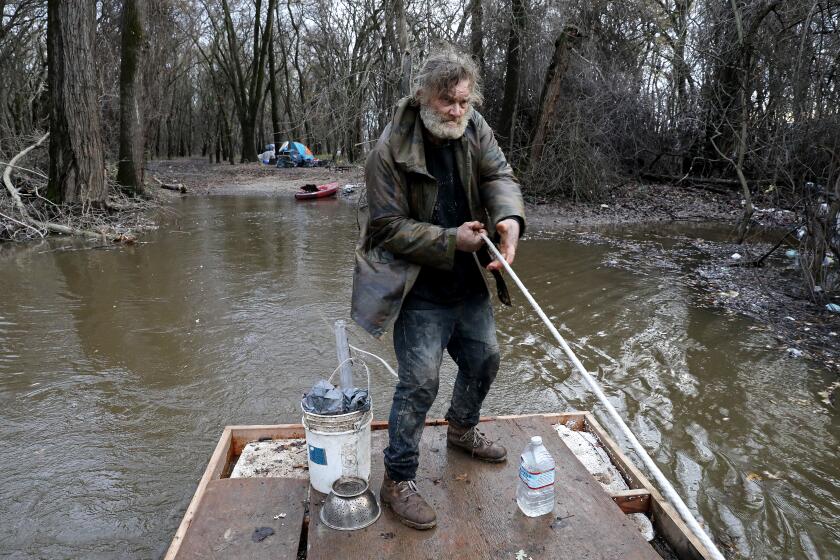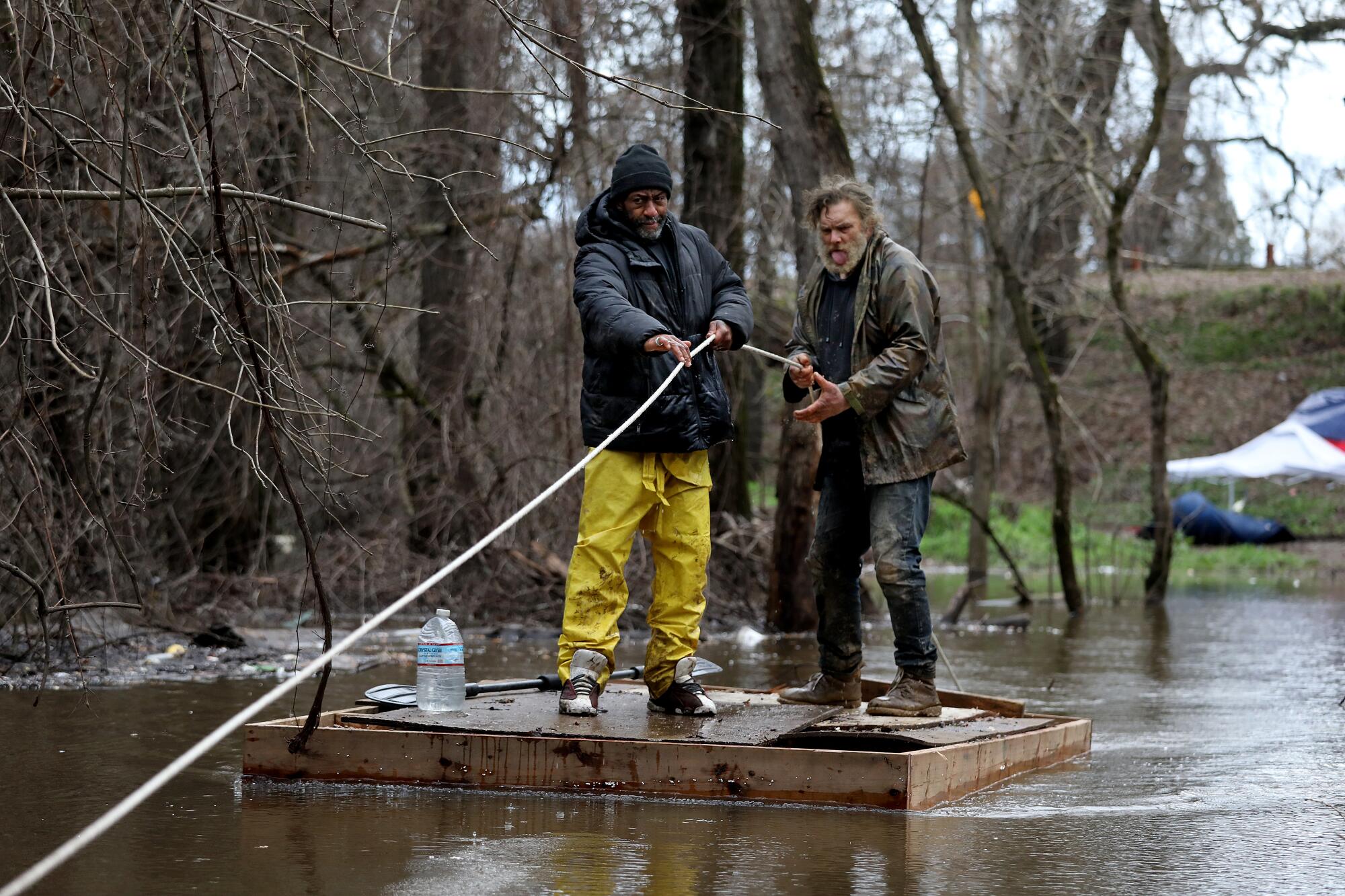
- Share via
SACRAMENTO — The raft to Bannon Island does not inspire confidence. But Dyrone Woods climbed aboard the piece of crumbling Styrofoam secured to the remains of a wood pallet anyway.
An atmospheric river was headed straight for the capital, prompting dire warnings about potentially deadly flooding and damaging high winds. Yet the raft, about the size of a refrigerator door, was his only way back to the tent where he has lived for five years, to his pit bull Bra Bra and his meager possessions.
“It’s rough right now,” Woods said as a hawk circled overhead, maybe eyeing mysterious bubbles on the surface of the water, indicating a creature underneath. “It’s cold. The weather’s changed. And I guess it gets old.”
We have written many times about the colliding emergencies of homelessness and extreme weather exacerbated by climate change.
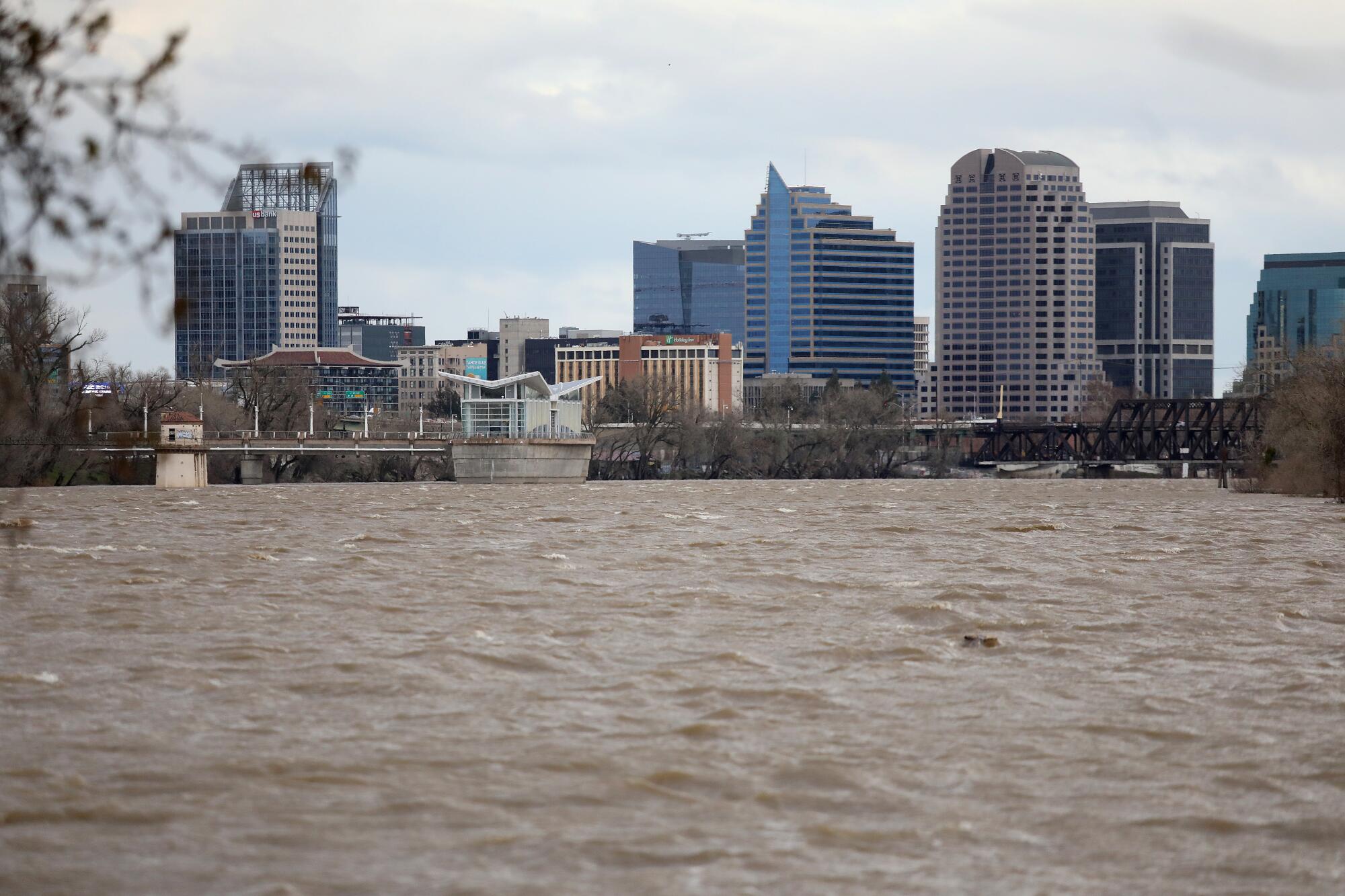
In the fall, as temperatures soared to unrelenting triple digits, we looked at how heat waves were making life harder for people living in tents on our sidewalks. And over the summer, we wrote about how disasters, such as wildfires, may one day force us into tough conversations about where and how we should live.
But few places in California demonstrate this better than Bannon Island, a sad spit of land between the Sacramento River and an old freeway that’s at once a few miles and a world away from the state Capitol.
A powerful winter storm that blasted Northern California with strong winds and heavy rain continued its march through the region Thursday.
For decades, even as politicians have talked about solving homelessness and building affordable housing, Bannon Island has been allowed to grow into a massive encampment, full of humans, dogs, tents, tarps, bicycles and other detritus both necessary and unnecessary for survival. One man even lives in an underground bunker; he dug his home, which is big enough for guests and a drum set, with a shovel.
Part of what makes Bannon Island notable is that it’s large and, akin to the much smaller mounds of land in the Santa Clara and Ventura rivers, is really only an island during storms.
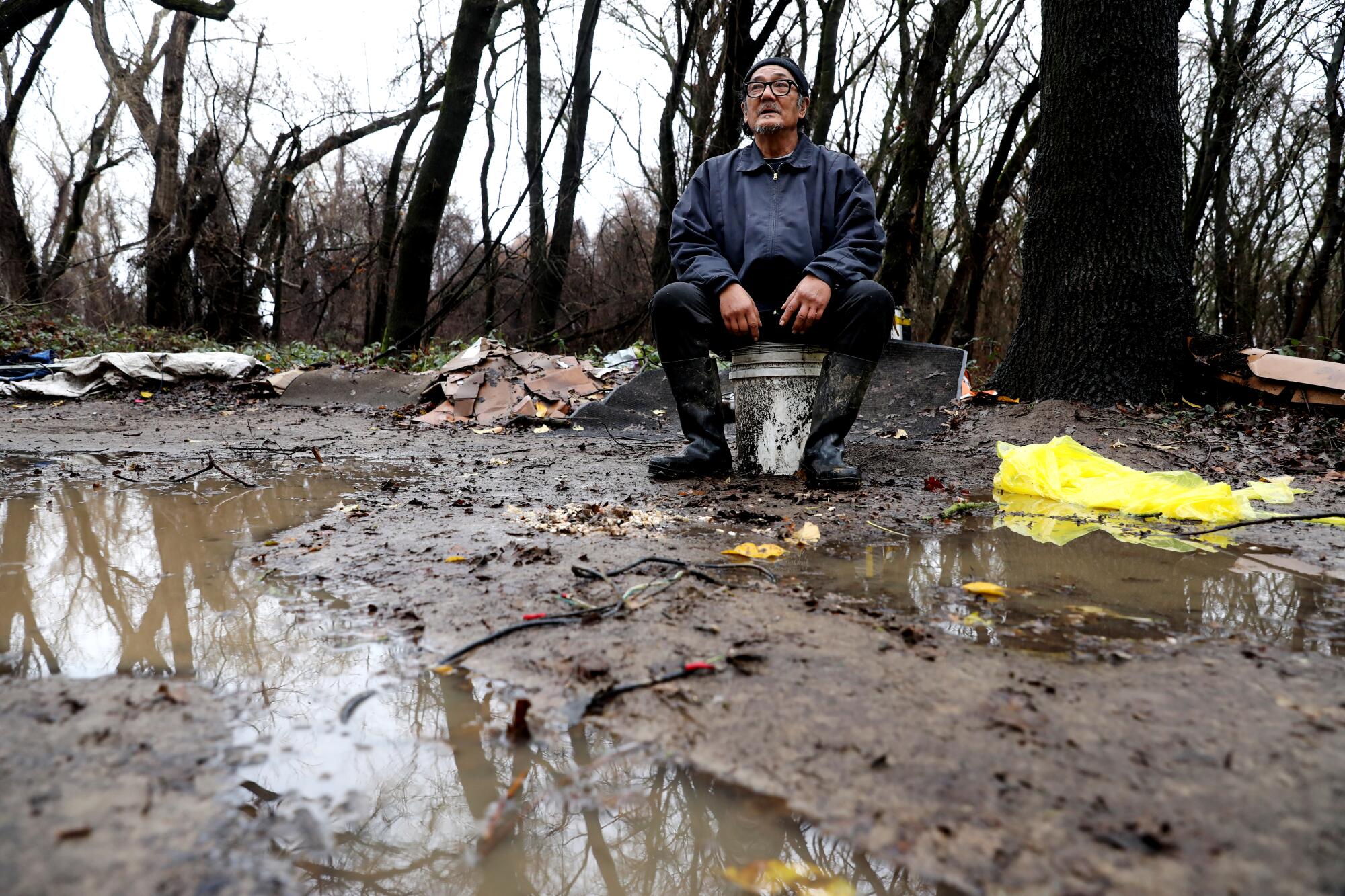
When it starts pouring, like it did last week — a situation experts fear will become more frequent as climate change leads California to extreme drought and extreme deluges — government officials release water from an upstream dam.
That protects the levees and prevents flooding in the residential and business neighborhoods that fill the flat lands of Sacramento. But as it does in many parts of California where unhoused people live along riverbeds, creeks and washes, it can lead to dangerous situations downstream.
One of those water releases, which sent what a state official described as 10,000 basketballs’ worth of water tumbling down the Sacramento River, happened a few days before New Year’s Eve, when a massive, wind-driven storm hit. That water deluged Bannon Island, leaving behind a wasteland of sole-grabbing mud under the barren oaks and cottonwoods, their trunks half-submerged in the murky channel.
By Wednesday, with another storm rolling in, the encampment had already been cut off from the mainland. That left about 60 residents weighing whether to accept government offers of shelter, move to higher ground or just ride out the rain, hoping the rising waters wouldn’t overtake them and force river rescues such as those that happened in Southern California.
One of us — Anita, because Erika is not that ridiculous — decided to join Woods on his treacherous voyage back across a 50-foot tributary of the swollen Sacramento River. The water is rumored to be head-deep in places, and not balancing one’s weight correctly on the makeshift raft is the fastest way to find out if the rumors are indeed true.
::
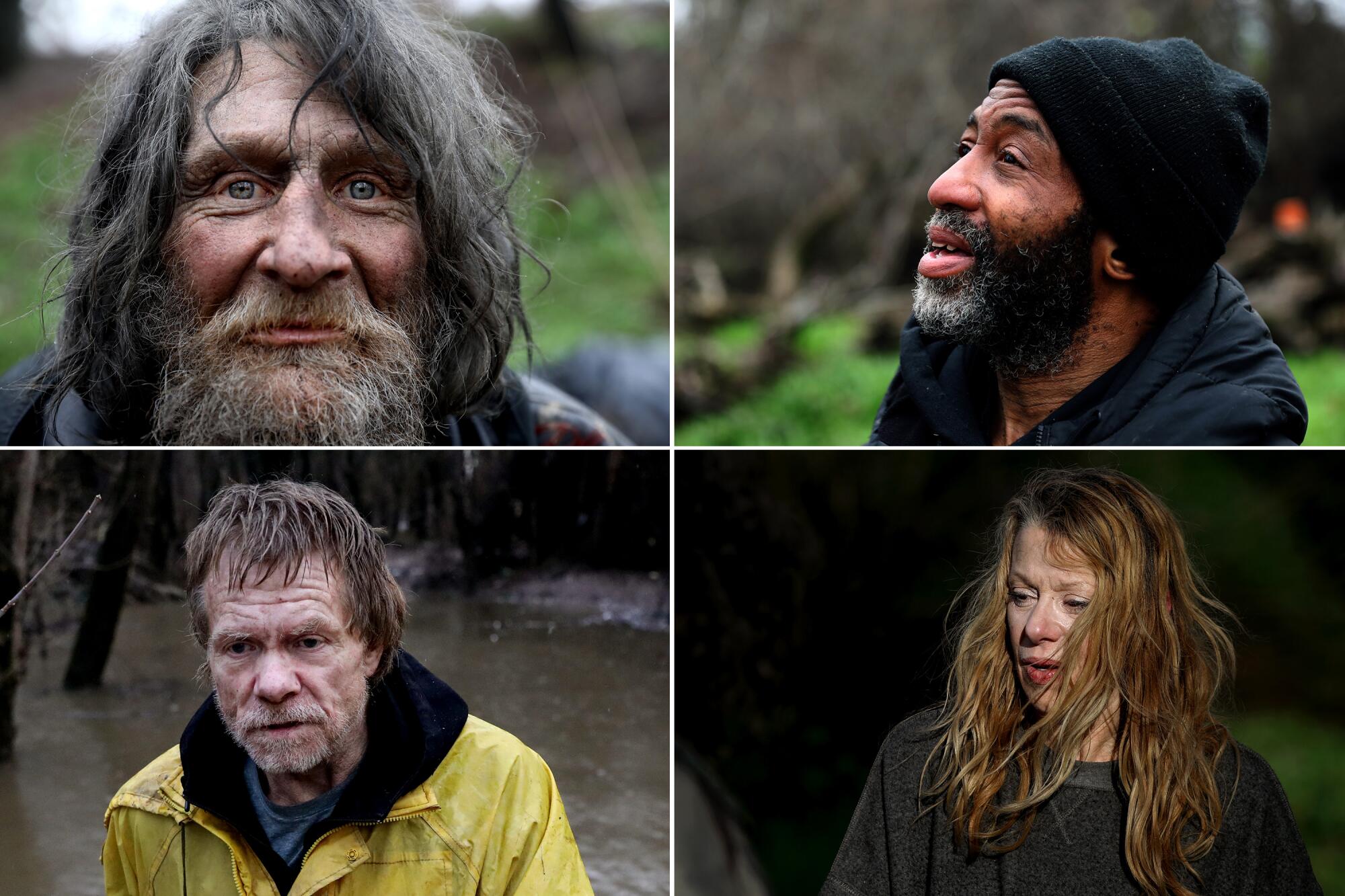
The circumstances on Bannon Island are dire but, increasingly, not unusual.
Across the U.S., 2 in 5 unhoused Americans last year were living outdoors, amid the elements, according to the latest data compiled by the U.S. Department of Housing and Urban Development. That represents an increase of 3% — about 7,752 people — since 2020.
Meanwhile, the number of Americans living in shelters actually dropped over the past two years, even as the homeless population remained relatively flat overall.
California is, of course, home to more unhoused people than any other state, and nearly 70% are unsheltered, living amid tangled tree branches on Bannon Island in Sacramento or under freeways in Los Angeles.
But now, Mississippi, Hawaii, Oregon, Arizona, Tennessee, Arkansas and Georgia also have more people in encampments than in shelters. This means more Americans than ever are vulnerable to extreme weather and climate change — and it’s starting to take a toll.
For Bob Erlenbusch, executive director of the Sacramento Regional Coalition to End Homelessness, this is deeply troubling. While he acknowledges that exposure to the elements isn’t directly responsible for the deaths of most unhoused people — we can blame drugs and violence for that — living outdoors certainly contributes to their suffering and shortens their lifespans.
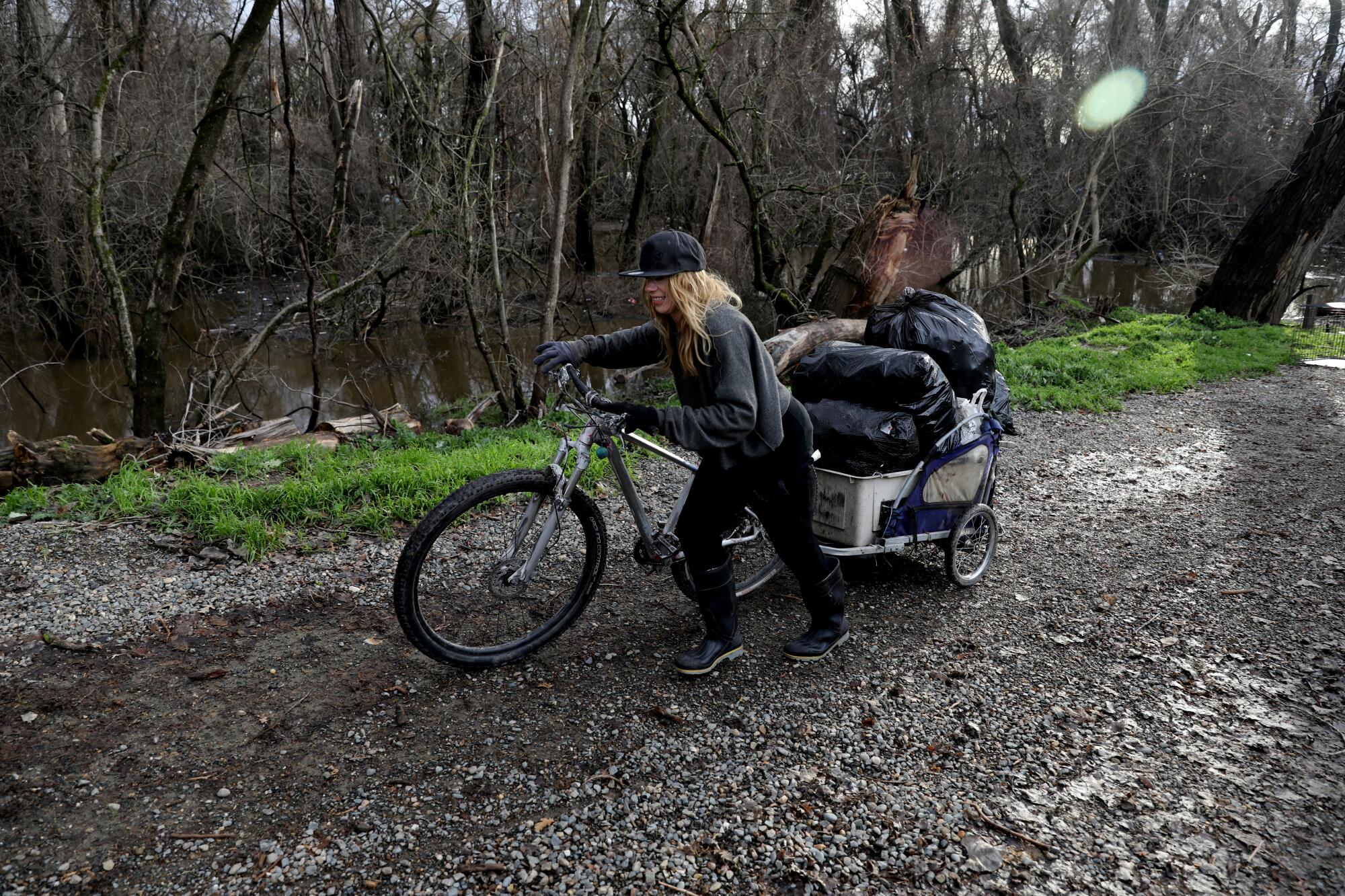
“Up until last year, there really weren’t weather-related deaths that we could identify, either winter or summer with the extreme heat. But that is changing,” Erlenbusch said.
Matt Fowle, a researcher with the University of Washington who has been tracking the deaths of unhoused people across the country, said he has seen an increase linked to extreme heat in Arizona and Nevada as concerns about climate change have grown in recent years.
“Often, governments are only willing to open shelters for a set period of time, when the heat gets really hot,” he said. “But there are many days when, for example, in Arizona, it’s 90-plus, and people need cooling centers.”
Then there is the growing need for clean-air centers, particularly in California, where climate-change-fueled wildfires send plumes of pollution into the sky.
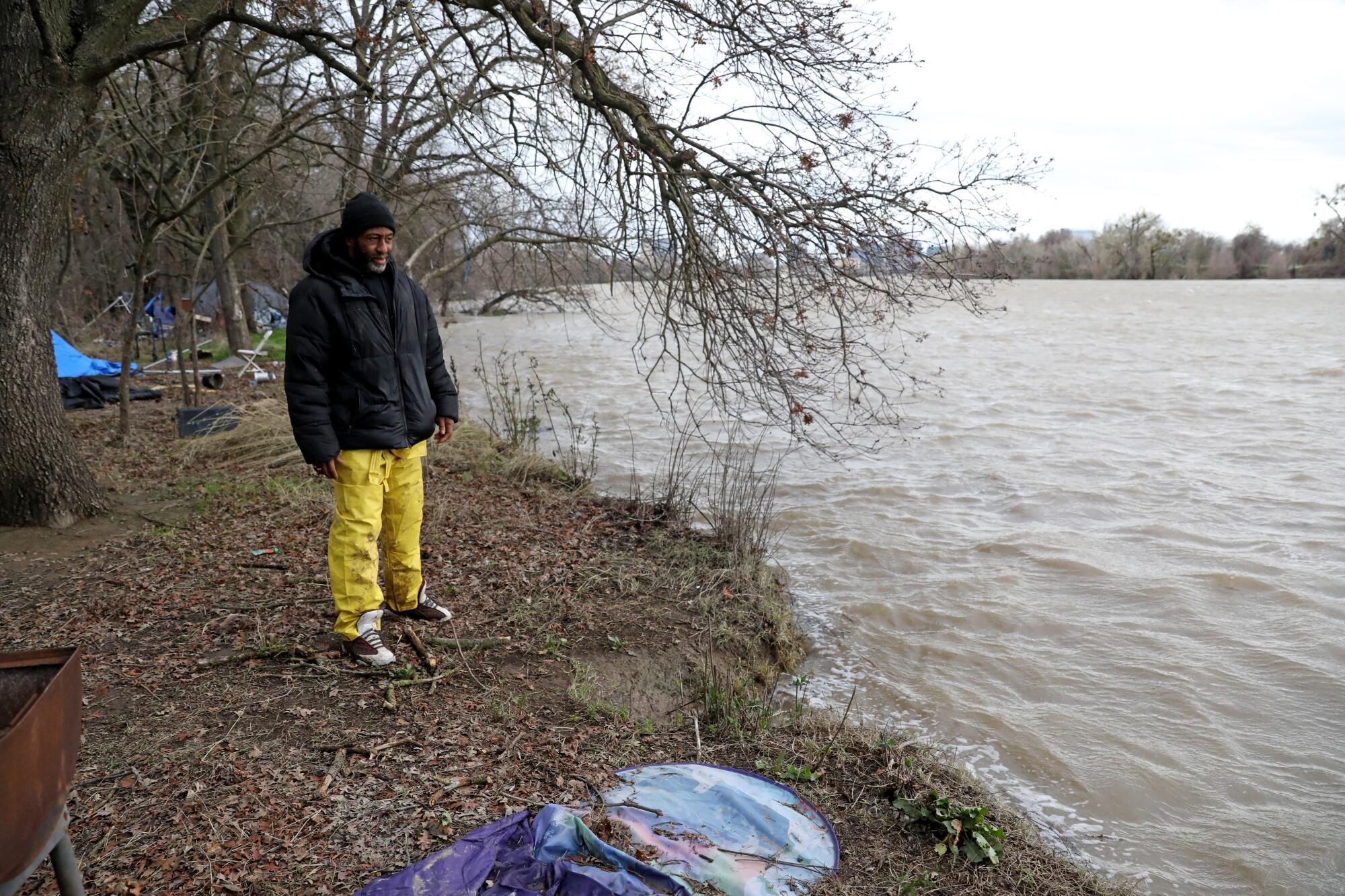
“The No. 1 health problem for people experiencing homelessness in our community is asthma,” Erlenbusch said. “So can you imagine being outside, having to breathe in the ashes from the burning fires, when it’s 105 degrees?”
For these reasons and others, Fowle “certainly” expects to see more extreme-weather-related deaths among the homeless population.
Already, men who live on the streets in Sacramento tend to die by age 49 or 50, said Erlenbusch, who runs the annual memorial service for the unhoused. Women tend to die by age 46.
As climate change makes crazy weather more common, it could prompt a new urgency around getting vulnerable homeless people into housing and shelter.
Woods, who is 50, recently lost his wife, Leticia Woods, to pneumonia. They had shared a black-tarp compound on Bannon Island with a view of downtown. Former high school sweethearts who reconnected on Facebook, they had been married for more than eight years. Woods said he is still processing the reality that he is alone.
He wants to leave Bannon Island — permanently, fearing, like many here, that he is too old for the increasingly harsh weather and conditions.
Another resident of the encampment, David Toney, said spring and fall seem to have disappeared in the past 10 years.
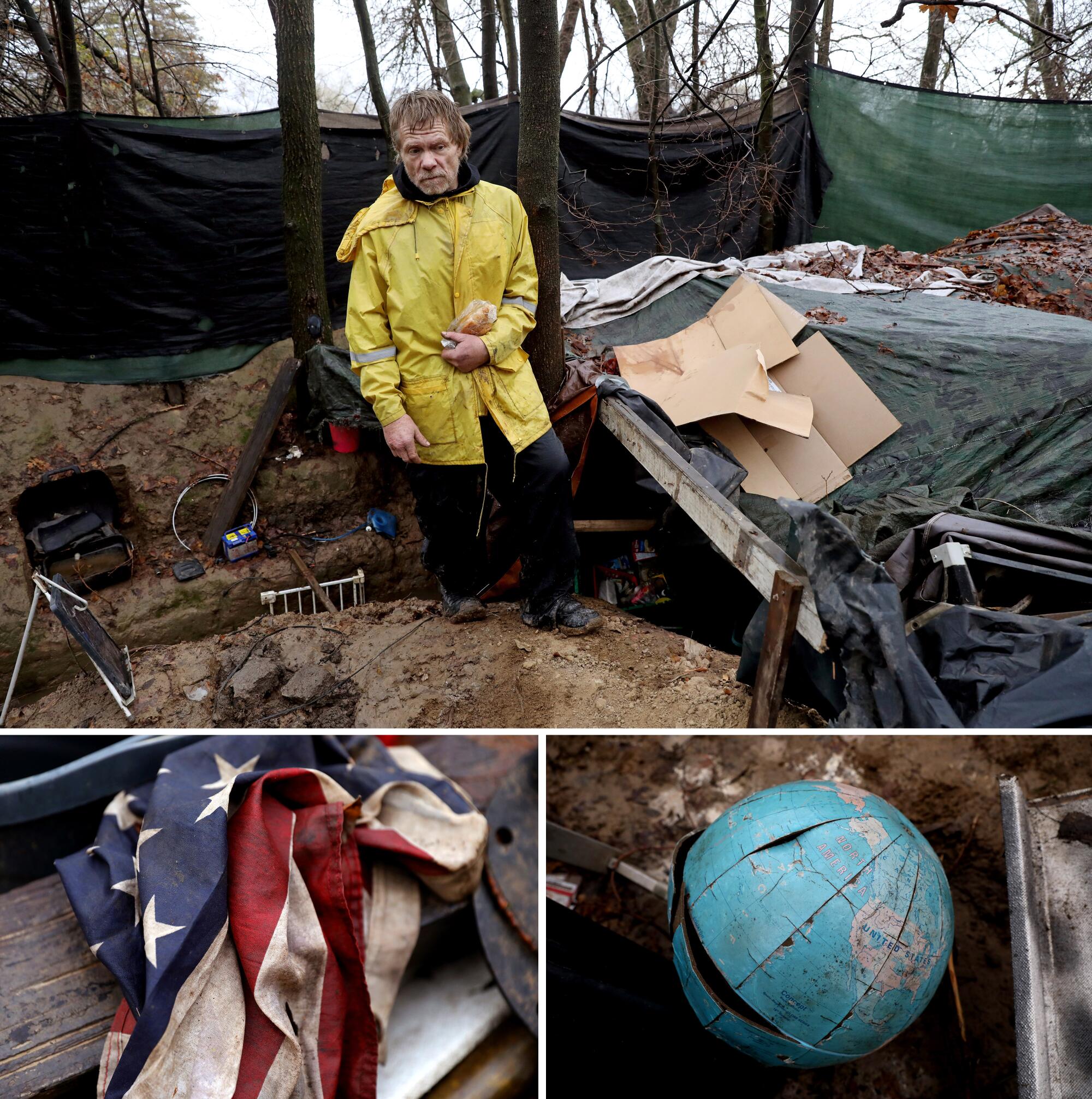
“It went from four seasons to basically just summer and winter,” he said.
The skyrocketing temperatures of the hot months prompted him to dig the bunker where he lives underground. It’s an impressive feat of engineering, with three earthen steps leading to a room deep enough that he doesn’t have to bend his 6-foot-plus frame to walk around. He added a fireplace along one wall to help with warmth during winters, which he says are growing colder.
As California braces for a massive storm this week, city leaders are rushing to bring homeless individuals into shelter.
But the Sacramento River is a mere 10 feet away, and when it rose, it filled Toney’s home in the ground. Days later, the water had receded a bit but was 3 feet deep, leaving only the cymbal of his drum set peeking above the unwelcome tide.
He’s afraid, he said. At 51, Toney has a double hernia, and his health is failing. The walk from the raft to his bunker home was painful, and who knows where another round of storms, predicted for this week, will leave him.
It’s the “hubris mentality” of society that leaves our most vulnerable to live outdoors with the greatest risks of extreme weather, he said.
But Toney’s experience should serve as a warning of what is to come with climate change — proof that the unhoused are already living the extreme-weather catastrophes that the rest of us fear.
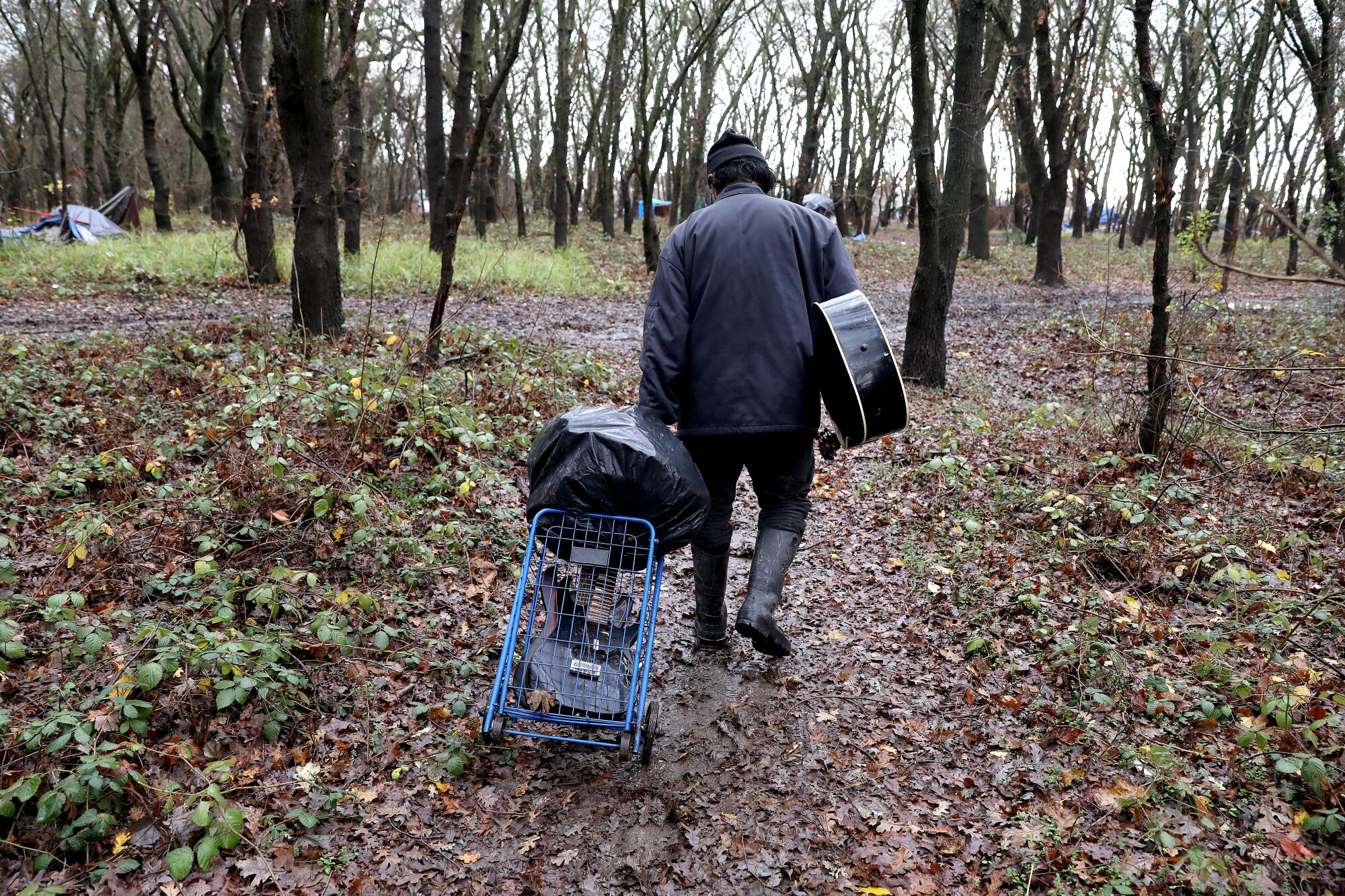
More to Read
Sign up for Essential California
The most important California stories and recommendations in your inbox every morning.
You may occasionally receive promotional content from the Los Angeles Times.
